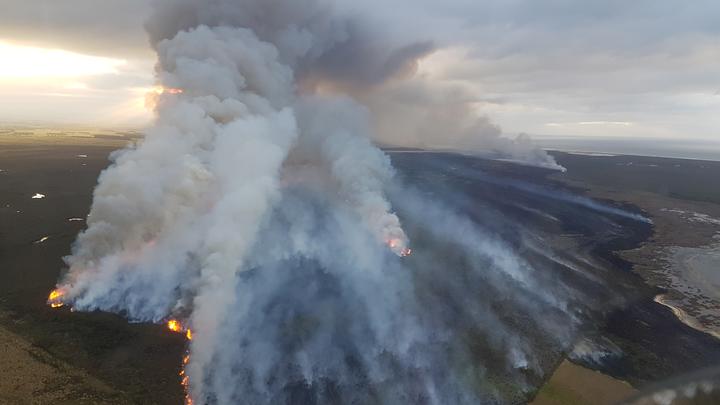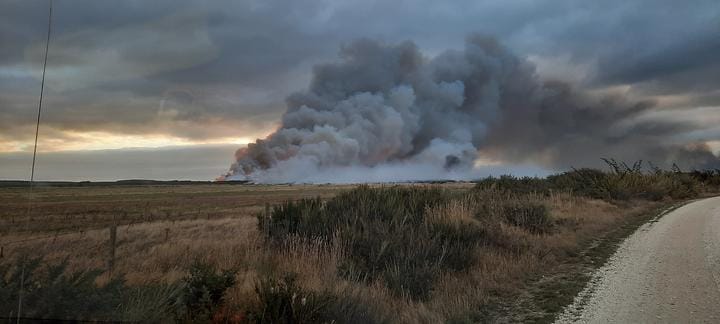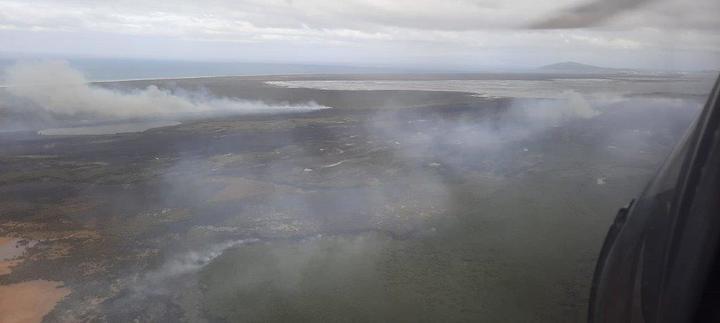
A major fire at Awarua, south of Invercargill, is burning through about a thousand hectares of mānuka scrub and peat soils.
An image of the fire burning in peat at Awarua, south of Invercargill, on 2 April, 2022.Awarua-Waituna, one of New Zealand’s largest remaining coastal wetland systems, is threatened by the fire south of Invercargill.
The uncontained fire, which started late yesterday afternoon, is mainly on Department of Conservation (DOC) land.
In a statement, Fire and Emergency NZ (FENZ) said the blaze extended from the head of Awarua Bay to the Awarua-Waituna Wetlands.
Awarua Bay Road has been closed to the public and people were asked to stay away from the area.
Nine helicopters and four ground crews were tackling the fire, with incident controller Mark Mawhinney saying they would be on site until dusk and would return at daylight tomorrow.
An extra crew would also be brought in from Otago tomorrow.
FENZ said the fireground was difficult to access on foot and crews were likely to be working for a fortnight or more to fully extinguish the fire.
It was tough work, Mawhinney said.
“It’s a bit ironic, you can fall into holes full of water while you’re trying to put out a fire, but equally there is the danger of falling into an ash pit, which could be 500 degrees celcius … these guys are doing it hard out there.
“Peat fires mean we’ll be out here for weeks – hopefully weeks, not months – but they are deep-seated fires, ashpits very hard to put out. That will be a real frustration, complicated by the drought that we’re having here in Southland.”
The area is an internationally significant wetland.
There are a number of fishing huts and maimai for duck hunters in the area and although they are in the direct line of the fire, none are at risk at the moment.
Mawhinney said the forecast was for a change in wind direction tomorrow so the fire could be going in an entirely different direction. He asked people to stay away from the area.
Smoke from a fire burning through 1000 hectares of manuka scrub and peat soils at Awarua, south of Invercargill, on 3 April, 2022.

The forecast was for a change in wind direction tomorrow, with easterly gusts of up to 45 knots, he said.
Bluff Community Board chair Raymond Fife said drought conditions had left the area quite dry.
“We haven’t had any rain of any description for months and it was a worry something like this could happen, even this time of year.”
Fife said he was concerned about how long it would take to put the fire out, given it was burning in peat.
Dean Whaanga, Kaiwhakahaere for Awarua Rūnaka, said Awarua-Waituna was significant to Ngāi Tahu whānau and to the local community.
“We are thankful for the quick response from Fire and Emergency as they go about protecting this special place and the taonga species that live there.”
An aerial image of the fire at Awarua, south of Invercargill, which was taken during a reconnaissance flight on the afternoon of 3 April, 2022.

Awarua-Waituna is one of New Zealand’s largest remaining coastal wetland systems, one of five significant wetlands in DOC’s national Awarai Kākāriki wetlands restoration programme. It is home to many wading birds and other species.
Source: rnz.co.nz Republished by arrangement.
